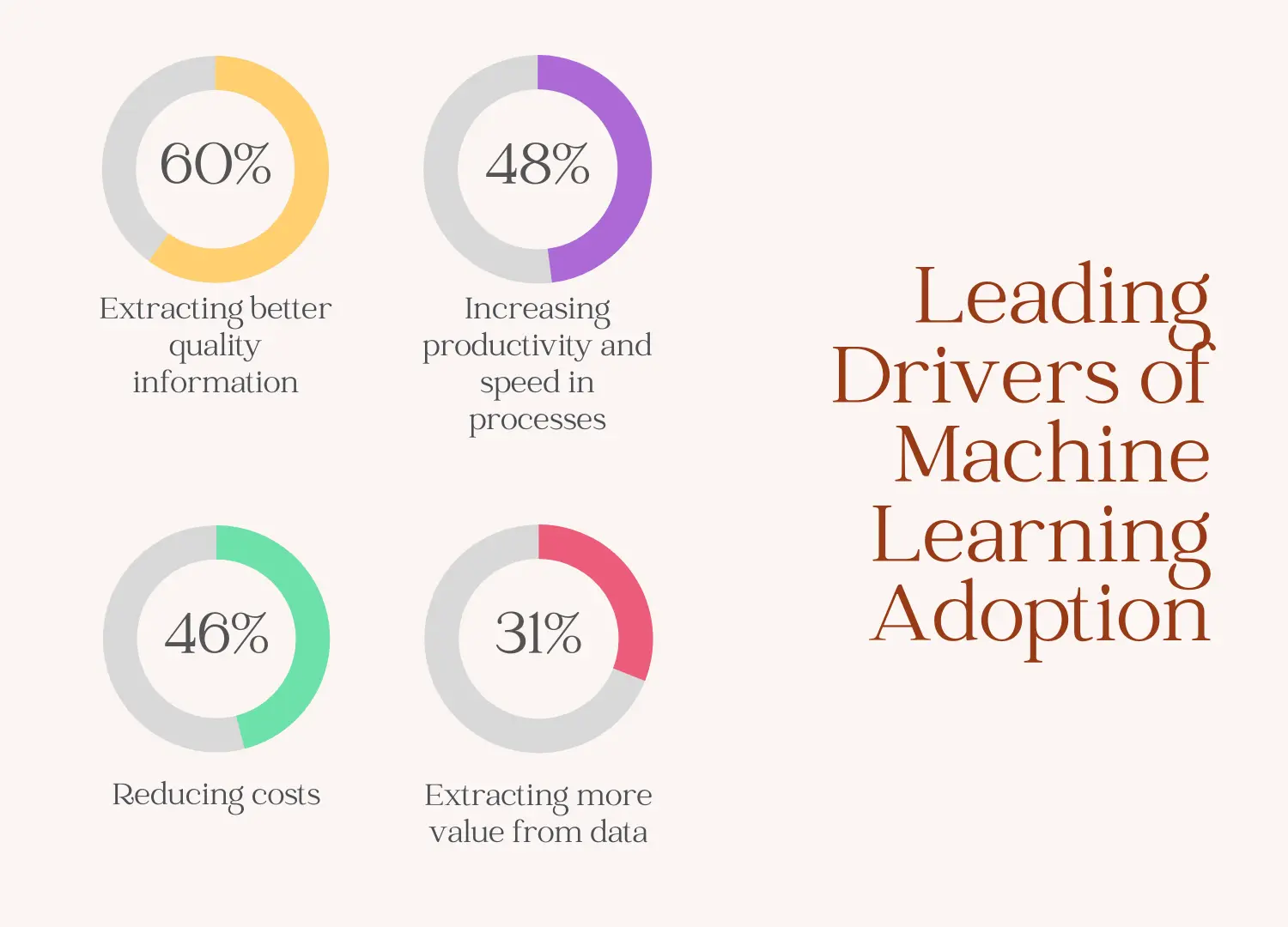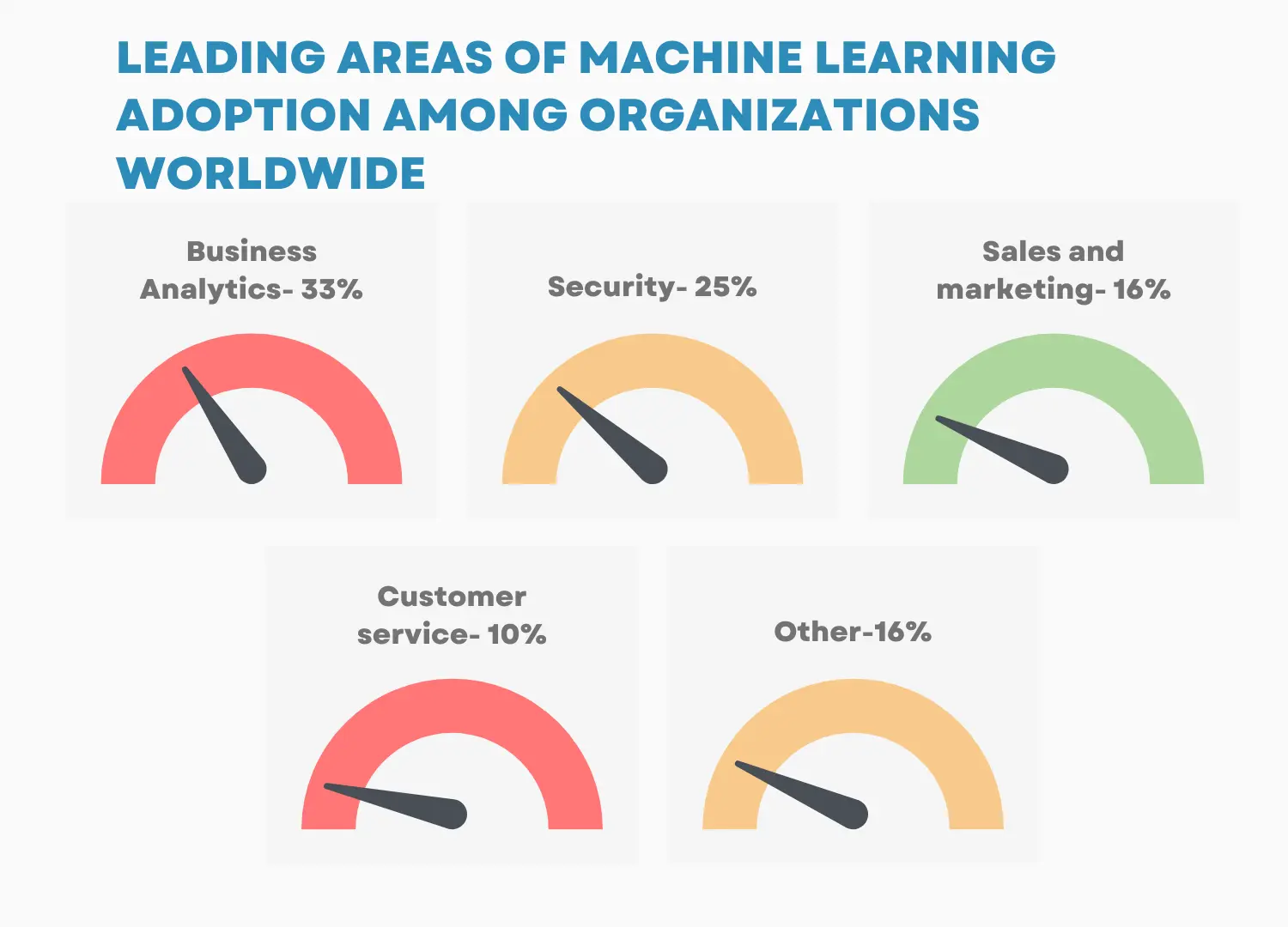Learning by machines was formerly considered science fiction, just like a lot of other technologies that are now commonplace in our society. Machine learning companies are getting very creative day by day. In 2023, the machine learning market experienced a growth of about 120%, compensating for a significant decline of 46 % in 2022. It is anticipated to develop steadily at a pace of about 20 percent for the majority of the decade until 2030 after these volatile years. Learning through machines has made our lives simpler. Data science is the engine that drives it. If they’re trained correctly and are taught correctly, they will complete their jobs faster and with greater efficiency than an individual could. This blog will cover the latest developments in the field of machine learning technologies in 2024.
Need for Staying Updated with Machine Learning Trends
Staying abreast of machine learning advancements is crucial in our rapidly evolving tech environment. This field primarily revolves around setting up algorithms that guide computers’ responses to data. With continuous breakthroughs and cutting-edge techniques emerging in the market, monitoring these trends ensures you’re equipped with the latest methodologies, algorithms, and computational models. Such knowledge empowers you to stay competitive globally, fostering the development of strategies that enhance efficiency and productivity.
Additionally, staying up to date allows you to adjust to the changes in the world and overcome difficulties. Strategies that don’t have the latest technology so that you can stay updated with the latest advancements technological advancements may not perform the same way, or be old. Staying abreast of new developments lets you move in different directions, and employ techniques that enhance your work’s quality, reduce the amount of duration you’re spending working on it, and boost the efficiency of your overall work.
Unlock the Power of Machine Learning Solutions in Your Business
Reach Out To A3Logics to try our machine-learning models
The Top Trends Shaping the Future of ML
Several trends are shaping the future of AI & ML. Some of them are mentioned below:
1. Federated Learning
Source: Google Cloud Tech
Federated Learning is a game-changing solution to machine learning that addresses privacy concerns and could change the game entirely. When dealing with sensitive material, traditional machine learning models necessitate the use of centralized data for training purposes, which might present several challenges. Federated learning allows for models to be trained across a variety of decentralized devices or servers, while at the same time allowing data to remain in its original location. The operation is as follows:
For instance, an application for healthcare professionals. Federated Learning makes it possible for the model to be managed locally on your device which means you do not have to download all of the medical information to a central server. The updated model is then sent through the server However, your data is not returned. This approach protects your privacy as well as the privacy of your data.
2. GPT-4
The newest variant of the generative pre-trained transformer is GPT-4. It became a breakthrough in natural language processing services. It can read and generate text like a human. GPT-4 stands useful for the creation of chatbots and even for translations.
GPT-4 has been trained on a very large dataset. It allows it to generate coherent and contextually rich text. This can be very instrumental in revolutionizing processes for content development and customer service, among other areas.
3. The Application of AI to Edge Computing:
Edge computing is an approach of data processing where processing takes place closer to the source of data, and is not dependent on the central cloud server. Edge computing can also be referred to by the name of near-line computing. Machine learning capabilities can be integrated into devices like phones, Internet of Things devices, and edge servers making use of AI for edge computing. It has many advantages such as:
High Latency: Real-time processes and decision-making are feasible if AI is implemented on the edges, which is vital for automated vehicles as well as industrial automation. Since the information is not transferred to a central server, both users’ privacy and security are enhanced.
Scalability is the capability of edge devices distributed to collaborate to accomplish complex tasks in machine learning. Artificial technology in edge computing makes devices smarter, giving them the ability to assess and act upon data at the local or global level. This ability is vital to an application called the Internet of Things (IoT) along with other applications.
4. Multimodal ML
Learning computer models and how to process and execute tasks. The globe is filled with different information, such as images, text, as well as audio. Therefore, having access to these data sources is extremely useful. The way it can be utilized.
Image Captioning: Multimodal AI can explain images using natural language, which can be helpful for persons who are visually impaired as well as for image indexing.
Voice Assistants: Multimodal ML can enhance the accuracy and capability of voice assistants by merging data from both text and audio.
5. Quantum Machine Learning and Its Applications
Quantum computing as well as machine learning have been amalgamated to create the area of quantum machine learning. Thanks to huge processing capabilities, they offer new opportunities to tackle the complex issues that arise from machine learning. Here are some important things to consider:
Algorithms used in Quantum Computing. Quantum computers are capable of completing certain calculations much faster than standard computers. It could bring about improvements in fields like pattern recognition, and optimization.
6. New Developments in Natural Language Processing:
Models such as BERT, GPT-3, and GPT-4 that take in context to produce more coherent words have had a huge influence on natural language processing. Machine translation’s accuracy improves thanks to NLP. It is aiding in breaking down the barriers to communication between countries and various cultures.
Sentiment Analysis: Natural language processing (NLP) can be used to perform the analysis of sentiment in the social media world and for customer feedback. It aids businesses in understanding public opinion and enhances their offerings.
Conversational AI: Authentic natural language processing is often referred to as Conversational AI. It is a key element in creating chatbots as well as virtual assistants. These can engage in real and meaningful interactions with real individuals.
Recent developments are a significant improvement in NLP solutions and offer a broad variety of uses in many disciplines, like the retrieval of information, customer service as well and content creation.

Other New Developments in the Industry
Beyond the issues that have been discussed to this point, the following interesting developments are shaping the machine-learning field:
XAI (Explainable AI):
XAI means explainable artificial intelligence, and defining it would involve the visioning of a myriad of AI approaches and strategies to make intelligible, plain, transparent, and expressively clear the way AI systems reach judgments or make predictions. The primary objective of XAI is to provide interpretability and accessibility of AI system decision-making to humans. One of the major challenges for machine learning models, particularly in deep neural networks, is that it is quite hard to understand why the model comes back with a certain conclusion. This opacity raises questions, especially in highly human-relevant applications, such as healthcare, financial, and self-driving cars, where the magnitude of the effects may be huge if mistaken or prejudiced choices are made.
XAI techniques try to enhance the visibility of AI systems’ “black box” nature and human-required understanding. The strategies are all different in terms of complexity, but they all concern developing models that can explain their predictions. On the other hand, XAI methods try to give users more information about how AI models make decisions. Explicit model representation methods, saliency mapping methods, and making the models simpler and more intuitive can be applied. Now, with the power of XAI, AI decision-making can be used to find biases and mistakes and make sure that it aligns with human values and standards.
AI Ethics and Prejudice Reduction:
As AI technology is increasingly used in people’s lives, so is the importance of eliminating biases and prejudices from AI models. AI systems do their job by learning from prior data. If that data contains prejudices, this could perpetuate and further amplify such biases through the AI models. This creates ethical issues, for by doing so, AI models can create unfair and harmful outcomes in areas such as hiring, lending, and criminal justice.
These are some of the measures that would mitigate prejudice in AI models: first, identifying bias within the training data and algorithms. This would be possible through the deep auditing and evaluation of AI systems. Actions to lessen and remove these biases can be taken upon discovery. This may include retraining models on more diverse and representative datasets, using fairness-aware algorithms, and shifting decision boundaries so that different groups are treated fairly.
Moreover, AI practitioners and researchers have teamed up to frame clear ethical principles and standards for the development and deployment of AI. If these principles are followed, an industry would be found that has helped in putting forward relatively more fair, accountable, and transparent systems of AI. AI ethical practices are fundamental in gaining the trust of people and for AI technology to benefit all.
Self-supervised learning:
Self-supervised learning is a novel technique to machine learning. It reduces the requirement for large labeled datasets, making it more accessible to researchers in a variety of domains. Models are trained on datasets that require manual labeling, which can be time-consuming and costly in typical machine learning. Self-directed learning is a more efficient option.
Models are trained on unlabeled data in self-supervised learning by creating labels or tasks from the data itself. A model can be trained to predict missing words in a sentence, for example, or to generate a new data point from an existing one (a process known as language modeling). This self-generated data can be used as the model’s training signal.
The ability of self-supervised learning to use large amounts of unlabeled data is a big advantage. This is especially useful in applications when labeled data is limited or prohibitively expensive, such as medical picture analysis or natural language understanding.
Unlock the Power of Machine Learning Solutions in Your Business
Reach Out To A3Logics to try our machine-learning models
Industry-Specific Trends of Machine Learning
These trends, specific to the industry, illustrate how machine learning is tailored to meet its unique challenges and opportunities. As technology continues to get better and better, the infusion of machine learning in these industries can only rise, changing the way business is run by transforming the customer experience.
Healthcare:
- Machine learning is transforming disease diagnosis, treatment planning, and medication discovery in the healthcare sector. There is more frequent use of personalized medicine powered by machine learning algorithms. The use of predictive analytics in healthcare also helps in the early diagnosis of disease and optimizes hospital operations.
Finance:
- Fraud detection and risk assessment are two important uses of machine learning in the financial industry. Intelligent algorithms can spot strange trends and anomalies in financial transactions, hence boosting security. Furthermore, robo-advisors use ML to give clients tailored investing ideas.
Retail
- Retailers are using machine learning to improve customer experiences. Customers get recommendations for products based on their past actions and interests through recommendation systems powered by ML.
- Predictive analytics solutions help inventory management by minimizing waste and optimizing stock levels.
Manufacturing
- Machine learning is useful for forecasting maintenance in the manufacturing industry. A machine learning consulting company can predict when equipment may break and schedule maintenance by analyzing sensor data from machines, minimizing downtime and expenses.
- Automation is also improved by machine learning-powered robotics and machines.
Agriculture:
- ML is applicable in agriculture through its use in precision farming. Crop health, soil conditions, and weather patterns are monitored through sensors and drones collecting data. These are then processed by machine learning algorithms to optimize the time to plant, irrigate, and harvest to result in greater yields.
Energy
- Energy corporations are using machine learning to optimize grids and predict maintenance.
- Smart grids employ machine learning solutions to balance energy supply and demand, thereby decreasing energy waste.
- ML also aids in the detection of equipment problems in electricity generation and distribution, thereby avoiding costly breakdowns.
Education
- Machine learning is personalizing learning experiences in education.
- Adaptive learning systems employ machine learning to personalize lessons to the strengths and limitations of individual students. As a result, it aids with retention and engagement.
Transportation:
- Machine learning is critical in driverless cars, route optimization, and safety.
- To make real-time driving judgments, ML models evaluate input from sensors and cameras.
- ML improves route planning and vehicle maintenance in logistics.
Entertainment
Content recommendation engines have transformed the entertainment sector.
- Video Streaming company utilizes machine learning algorithms to recommend movies, music, and shows to keep users interested.
- ML is also useful in generating deepfake content and improving special effects.
Real Estate:
ML applications in real estate include
- property valuation,
- anticipating housing market changes, and
- optimizing property management.
Algorithms examine historical data and market indicators to assist investors and homeowners in making sound judgments.

What the Future Holds for Machine Learning
Machine learning is quite an interesting subject and promises to do great things in the future as far as peoples’ interactions with technology are concerned. It teaches computers to learn and make independent decisions, much like humans do from the various experiences occurring throughout life. Some of the reasons machine learning is going to be big shortly are:
- Better Automation – The use of machine learning helps improve automation. The self-driving automobile’s computer systems use machine learning to try and determine what actions to take when they are out on the road. This can make our lives much easier but also helps to ensure that we remain safe.
- Better Health Care System: Machine learning comes in handy helping medical professionals to go through the vast amounts of data from patients, thereby enabling the doctors to reach faster and more accurate diagnoses. Moreover, it could be used in finding new pharmaceuticals, hence fastening the rate of discovery for new medicines.
- A better customer experience: It is machine learning that helps websites like Amazon and Netflix give personalized recommendations to you. These are based on your preferences and suggest what might interest you. With such an advantage, you will have a more prominent extent of control in buying and leisure activities.
- Predictive analytics: Extrapolation of past events to make educated guesses about what will happen in the future is what machine learning can do. For example, it helps businesses predict how much money they will generate. This is good for planning and to take suitable corresponding action as a company.
Artificial intelligence solutions company empowers virtual assistants like Siri and Alexa to understand better whatever is said to them when they are being spoken to. With the machine learning technology going forward, these assistants will help all the more.
Take Maximum Advantage of The New Emerging Machine Learning Trends
Connect with the leading machine learning solutions company
Conclusion
In the world of changes, technology is one change that happens in the blink of an eye. It is important to keep up with the burgeoning trends in machine learning. These advancements happen to continually change not only the future scope of technology but also many other fields, be it in banking or healthcare. Keeping up with these changes can help businesses and professionals make better their goods, services, and decisions thanks to machine learning. Also, the knowledge of these trends helps us in the way we deal with social problems, including reducing bias and being open and honest. As the field of machine learning continues to expand, staying competitive and current will heavily depend on the extent to which one continues to learn and adapt to the changes.
FAQs
The following are some common questions regarding machine learning, along with concise solutions to each of them:
What is “machine learning (ML)”?
Machine learning is a sub-field in artificial intelligence that aims at developing algorithms and models through which computers can learn from data to make predictions or judgments without explicit programming.
How does this benefit my business commercially?
Just imagine if you incorporated machine learning into your business: it becomes more effective, better at handling many tasks, and making decisions based on data, hence enhancing the customer experience. This could save money while having the lead in front of the competition.
What types of machine language companies can benefit from machine learning applications?
Almost every kind of company can benefit from machine learning. It is making a big impact in areas including health, banking, e-commerce, manufacturing, transportation, etc.
What are the charges related to the usage of machine learning?
The price of machine learning solutions varies drastically, depending on the nature of the problem you want to solve and, generally speaking, the size of the problem. To receive a more precise quotation, you should detail your requirements and your budget to A3Logics.
Do I have to be a coder or a data handler if I utilize machine learning solutions?
Be it machine learning approaches, no coding or data wrangling on your end is necessary. A3Logics will train and guide you so that you can derive full benefit from their artificial intelligence services, no matter how tech-savvy you may be.












